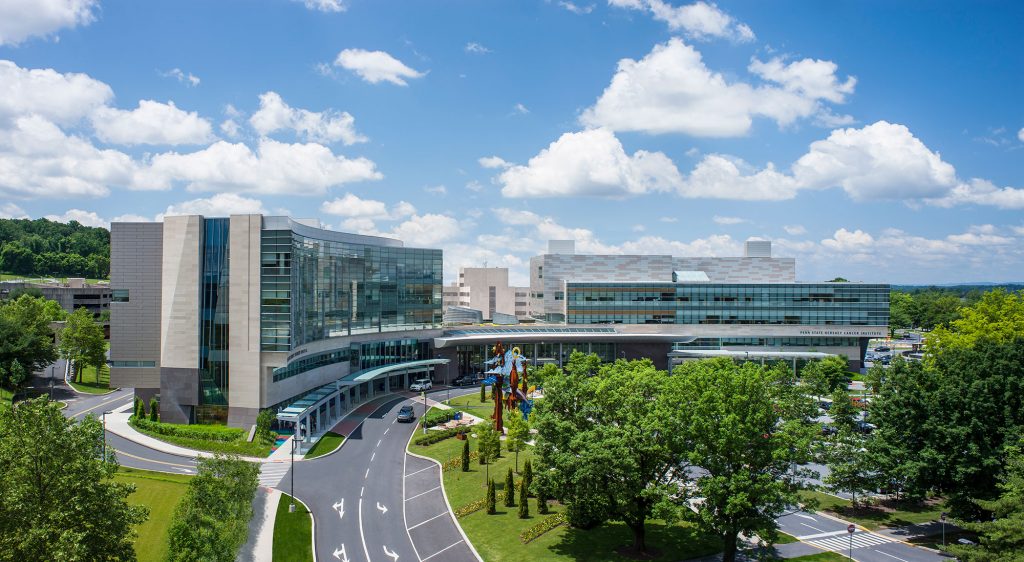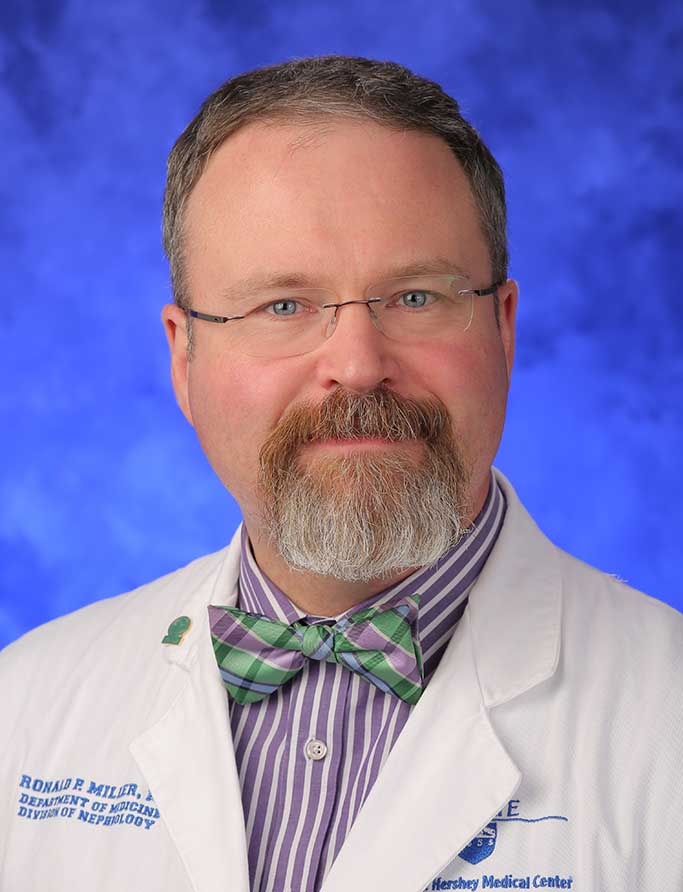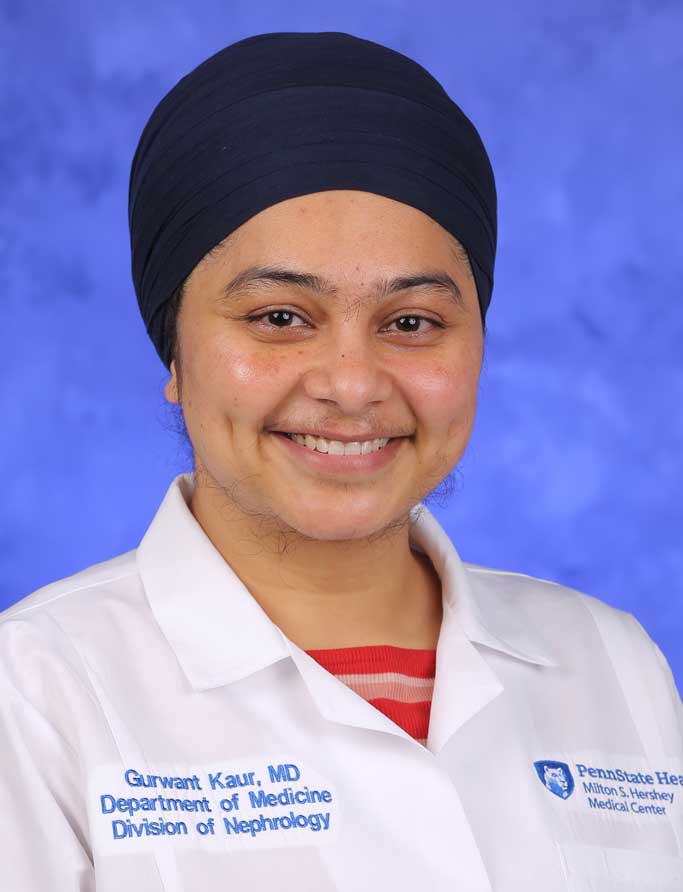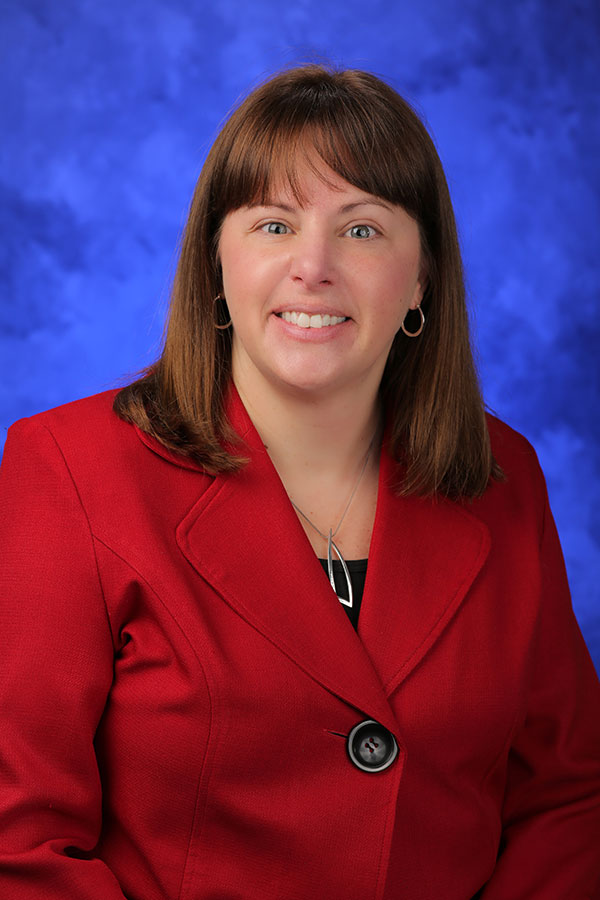Jump to topic
Search
Program Details
Penn State Health Milton S. Hershey Medical Center’s Nephrology Fellowship prepares the trainee for clinical or academic adult nephrology. The program also trains clinician-scientists to become competitive clinical researchers.
The program provides trainees with state-of-the-art training in both clinical and research pathways. Training is conducted on the campus of Penn State Health Milton S. Hershey Medical Center, a quaternary-care institute that cares for patients with a broad spectrum of pathologies. The campus offers a colocation of basic, translational and clinical science, patient care and Penn State College of Medicine all on one campus. The program is designed to meet all requirements for board eligibility in nephrology upon completion.
Clinical training covers a full array of experiences in dialysis, renal transplantation, hypertension, inpatient service, consultation service and outpatient and long-term follow-up activities. All modalities of dialysis are available, including in-center and home hemodialysis, acute hemodialysis, chronic peritoneal dialysis and continuous renal replacement therapy.
Combined with the well-rounded clinical training is a rigorous didactic learning environment. The fellowship has many active research projects. Some topics of interest include inflammation and diabetic nephropathy, the natural history of acute kidney injury, a peer-led mentoring program for patients with chronic kidney disease and their caregivers, geographic disparities in kidney disease management, tissue plasminogen activator in renal fibrosis and genetics in acute kidney injury.
Learn More about the Fellowship
- Robust training in transplant nephrology with a multidisciplinary team approach
- Apheresis training with opportunity for credentialing in therapeutic apheresis
- Extensive exposure to critical care patients, particularly in the heart and vascular ICU
- An emphasis on peritoneal dialysis in both clinical and didactic settings
- Simulation lab training in central line placement
- PA-run ESRD service and PA coverage for inpatient fellow during continuity clinic
- Weekly protected scholarly activity half-day
- Consistent annual abstract submission to the American Society of Nephrology
- Financial support for national conference attendance
- Participation in the Mid-Atlantic Fellowship Boot Camp
General Application Information
Two fellowship openings are available each year. Fellowship applications are accepted through ERAS starting July 1. Interviews take place from August to October. Match results are available in December.
Submission of complete ERAS applications by July 1 is highly recommended. The program only supports J-1 visas.
Application Requirements
Applicants must be in an ACGME or ACGME-I residency program, and will need to have passed all three USMLE steps before starting fellowship.
Application requirements include:
- Three letters of recommendation
- A personal statement describing the applicant’s goals in nephrology
- USMLE transcript
- If applicable, ECFMG status report
- ERAS application
What makes a competitive applicant varies between programs, but successful fellows tend to demonstrate:
- A solid breadth and depth of internal medicine knowledge
- Mature clinical decision-making
- Interest and ability in research (even if that isn’t their career goal)
- Calm professionalism
- Genuine drive to become excellent nephrologists
Virtual Tour
Penn State Health
Penn State Health is a multi-hospital health system serving patients and communities across 29 counties of Pennsylvania. Its mission is to improve health through patient care, research, education and community outreach.
In December 2017, the system partnered with Highmark Health to facilitate creation of a value-based, community care network in the region. The shared goal of Highmark and Penn State Health is to ensure patients in the community are within:
- 10 minutes of a Penn State Health primary care provider
- 20 minutes of Penn State Health specialty care
- 30 minutes of a Penn State Health acute care facility
Learn more about Penn State Health

Penn State Health Children’s Hospital (left), Penn State Health Milton S. Hershey Medical Center (center) and Penn State Cancer Institute (right)
Penn State Health Milton S. Hershey Medical Center
500 University Dr., Hershey, Pa., 17033 (Derry Township, Dauphin County)
- The health system’s 647-bed flagship teaching and research hospital
- The only medical facility in Pennsylvania accredited as both an adult and a pediatric Level I (highest-level) trauma center
- Dedicated surgical, neuroscience, cardiovascular, trauma and medical intensive care units
- Accredited Life Lion critical-care transport providing more than 1,100 helicopter and approximately 750 ground ambulance transports per year
- More than 1,300 faculty members and more than 650 residents and fellows
- Approximately 29,000 admissions, 73,000 emergency department visits, 1.1 million outpatient visits and 33,000 surgical procedures annually
- Designated as a Magnet hospital since 2007
Learn more about Milton S. Hershey Medical Center
Penn State Health Children’s Hospital
600 University Dr., Hershey, Pa. 17033 (Derry Township, Dauphin County)
- An eight-story, 263,000-square-foot-facility built in 2013 and expanded in 2020
- 160 licensed pediatric beds, 26-bed pediatric intensive care unit and a 56-bed neonatal intensive care unit
- Level IV (highest-level) neonatal intensive care unit
- Level I quaternary (highest-level) pediatric intensive care unit
- Level I (highest-level) pediatric trauma center designation
- Intermediate care unit
- Dedicated pediatric operating rooms
- More than 150,000 pediatric outpatient visits, 20,000 pediatric emergency room visits, and approximately 5,000 pediatric patient discharges annually
Welcome to Hershey
More About Hershey
Interested in learning more about living and working in Hershey, Pa.? See details here:
Wellness, including emotional, spiritual, social and physical health, is a crucial component to training and to becoming a professional, compassionate and resilient physician. Self-care is a skill which must be continually practiced and reinforced. Penn State College of Medicine and Penn State Health are committed to addressing wellness among residents and fellows, with multiple resources readily available.
Institutional resources
- Visit BeWell – a health program designed to support Penn State Health employees
- See Penn State College of Medicine wellness resources here
- Employee Health Care Concierge and Case Management Service
- Partners in Medicine
Moving to a new city with your family does not have to be stressful. Residency programs have assisted many significant others with finding employment. There is also a GME-Wide Partners in Medicine (PIM) group that offers networking opportunities as well as various social and community oriented activities. - The Doctors Kienle Center for Humanistic Medicine
- Active and easily accessed Office of Professional Mental Health
Graduate medical education resources
Institutional Resources
Penn State Health and Penn State College of Medicine celebrate, embrace and support the diversity of all patients, faculty, staff, students and trainees.
Office for Diversity, Equity and Inclusion
In keeping with this, Penn State Health has an active Office for Diversity, Equity and Inclusion with various programs, networks and resource groups, including:
- Talks and lectures on diversity, equity and inclusion through the Inclusion Academy
- Regular events on topics such as eradicating racism and creating a culture of inclusiveness
- Many Business Employee Resource Groups (BERGs), including:
- Disability Business Employee Resource Group
- Interfaith Business Employee Resource Group
- LGBTQ+ Business Employee Resource Group
- Military and Veterans Business Employee Resource Group
- Multicultural Business Employee Resource Group
- NextGen Business Employee Resource Group
- Black Physician Professional Staff Association – Resource Group
- Hispanic Professional Association
- Asian Physician and Professional Staff Association
- International Workforce Inclusion
Learn more about the Penn State Health Office for Diversity, Equity and Inclusion
Learn more about the College of Medicine’s Office for Diversity, Equity and Belonging
Office for Culturally Responsive Health Care Education
The vision at Penn State College of Medicine and Penn State Health is to equip learners with the knowledge, skills and attitudes they will need to provide culturally excellent health care and research for an increasingly diverse U.S. population. The Office for Culturally Responsive Health Care Education was formed to help meet that goal.
Learn more about the Office for Culturally Responsive Health Care Education
Office for a Respectful Learning Environment
In addition, the institution does not tolerate discrimination, biases, microaggression, harassment or learner mistreatment of any kind, and any concerns are immediately addressed by the Office for a Respectful Learning Environment.
Learn more about the Office for a Respectful Learning Environment
Network of Under-represented Residents and Fellows
The Network of Under-represented Residents and Fellows (NURF) is a group of diverse residents and fellows representing all specialties. NURF’s goal is to promote cultural diversity in the residency programs through community involvement, mentorship with diverse faculty, professional networking and support for the recruitment of diverse medical students into the residency programs.
NURF is sponsored by the Penn State College of Medicine Graduate Medical Education Office and the Penn State Health Office for Diversity, Equity and Inclusion.
Curriculum Details
The inpatient consult service sees patients with acute renal failure, electrolyte and acid-base disorders and severe hypertension, as well as following end-stage renal disease patients requiring hemo- or peritoneal dialysis. The program maintains a teaching service census of approximately 20-40 patients, with two to five new consults per day. Critically ill patients in intensive-care settings (MICU, SICU, heart and vascular ICU, neuro ICU and associated intermediate-care units) make up a third to half of a typical census. Fellows supervise and teach residents and students on the service, with additional support from two physician assistants.
The transplant service performs 40 to 50 kidney and kidney/pancreas transplants per year. Fellows see patients in the clinic pre-transplant, present them in selection meeting, follow them in the hospital in the peritransplant period and maintain follow-up in the post-transplant clinic setting. Fellows also see long-term follow-up transplant patients as part of the continuity clinic. The exposure to patient selection, advanced immunosuppressant therapies, post-transplant management and long-term follow-up ensures that the fellow has a superior skill set in dealing with transplant patients in both in- and outpatient settings.
A cadre of 40 hemodialysis patients make up the core of the fellows’ outpatient hemodialysis experience. Fellows see approximately 15 patients in the peritoneal dialysis clinics monthly. The program provides an extensive amount of peritoneal dialysis training to fellows, which enables them to not just be competent in that modality, but to advance the cause of peritoneal dialysis after fellowship. Fellows have the opportunity to attend a national extramural course in peritoneal dialysis as well, further expanding their abilities.
The fellows’ continuity clinic is held weekly. Fellows will see one to two new and four to six follow-up patients per clinic along with the attending. As a referral center, the outpatient patient mix includes both common (CKD, hypertension), advanced (renal transplant, CKD in other solid organ transplant patients) and unusual cases (atypical or complex glomerular disease presentations).
Fellows have the opportunity for elective rotations in critical-care nutrition (TPN management), pediatric nephrology, renal imaging and intervention and renal pathology. A stone clinic, co-managed with nephrology and urology, is available for fellow exposure to the metabolic evaluation and treatment of nephrolithiasis. Each fellow will rotate on the apheresis service, and will be able to gain qualification in therapeutic apheresis such that, post-fellowship, they would be qualified to be a medical director of an apheresis service per the American Society for Apheresis guidelines. Fellows on the apheresis service also interact with the transplant service in dealing with patients requiring plasma exchange for treatment of antibody-mediated rejection or reduction of donor-specific antibodies.
The first year of training is heavily concentrated on inpatient consult service, with some exposure to transplant and outpatient dialysis. The second year brings more longitudinal exposure to chronic in-center hemodialysis and peritoneal dialysis. Research time is spread throughout the year to allow the fellow to initiate and complete a meaningful project. Depending on the interests and goals of the fellow, projects are possible in both basic and clinical science.
A goal of this activity is a peer-reviewed manuscript, or other scholarly output at that level. Past fellows have had poster and oral presentations at national meetings; submitted peer-reviewed publications; written successful IRB protocols; and obtained extramural grant funding.
While not all fellows plan to pursue clinical research after fellowship, motivated and skilled trainees will find challenging research work that can form the basis for further exploration.
Conferences are scheduled throughout the year, with specific sessions in July and August set aside for orientation topics. Fellows participate in planning and giving talks to the division, with additional time for this in the second year. The yearly renal medicine course for second-year medical students offers additional opportunities for small-group session teaching and facilitation.
Scheduled conferences include:
- Clinical case conference (each Tuesday, noon)
- Weekly conference (Tuesdays, 4 p.m.; topics rotate weekly)
- Basic science
- Grand rounds
- Biopsy conference
- Literature update
- Monthly departmental research conference
- Core curriculum (Thursday, noon) with emphasis on:
- Renal physiology (spans both years)
- Physiology of hemo- and peritoneal dialysis
- K/DOQI and NephSAP review
- Transplant conferences
- Kidney transplant selection conference (Thursday afternoon)
- Transplant biopsy conference (every other Friday afternoon)
- Donor advocacy meeting
- HLA meeting
- Weekly sign-out rounds and case discussion (Friday afternoons)
- Vascular access conference (third Wednesday of each month)
- ACGME Core Competencies conference (first Tuesday of each month)
- Morbidity and Mortality (M and M) Conference (third Thursday of each month)
Program Director Dr. Ronald Miller shares a recommended article for fellows each week, along with his thoughts about the implications of the research. Using the search box below will filter articles by keyword, title or author.
Fellow Honors and Recognitions
Penn State College of Medicine and Penn State Health Milton S. Hershey Medical Center accept ongoing nominations for the Exceptional Moments in Teaching award.
The award, given monthly by the Office for a Respectful Learning Environment, accepts nominations from College of Medicine students who are invited to submit narratives about faculty members, residents, fellows, nurses or any other educators who challenge them and provide an exceptional learning experience. See more about the award here.
Previous nominees from the Nephrology Fellowship are listed here. Click the + next to a nominee name to read their nominator’s comments.
Previous oral and poster presentations from the Nephrology Fellowship are listed here.
A selection of recent peer-reviewed publications with Nephrology Fellowship trainees as authors appears here.
Latest News from Nephrology






